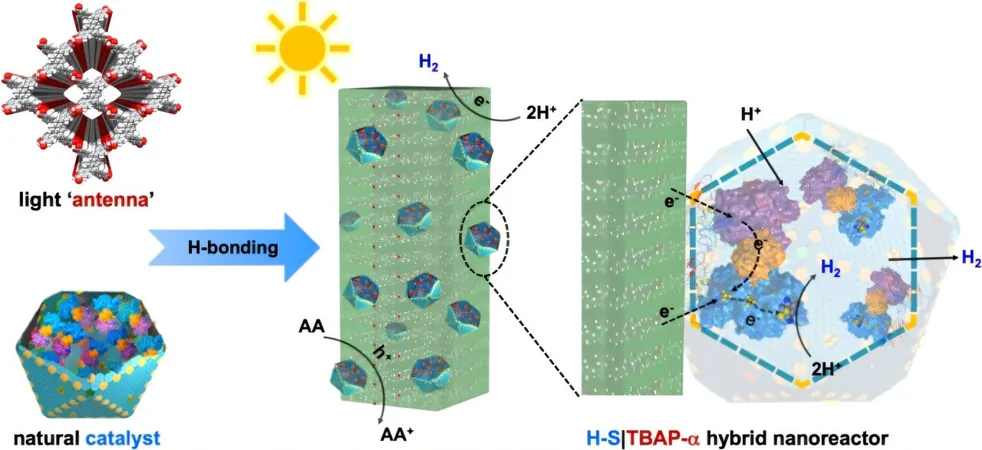
Revolutionary Light-Driven Hybrid Nanoreactor Sets New Standard for Affordable Hydrogen Production!
2024-12-17
Author: Jia
Introduction
In a groundbreaking development that could reshape the future of clean energy, researchers at the University of Liverpool have unveiled an innovative light-driven hybrid nanoreactor designed to produce hydrogen—a key player in the quest for sustainable energy. This remarkable advancement merges the natural efficiencies found in biological systems with the precision of synthetic chemistry, presenting an eco-friendly solution to one of the most pressing energy production challenges.
Study Published
Published in the esteemed journal ACS Catalysis, this study introduces a novel approach to artificial photocatalysis, targeting the critical hurdles associated with harnessing solar energy for fuel generation. While nature has perfected its own photosynthetic systems for maximum sunlight efficiency, replicating such performance in artificial systems has proven elusive—until now.
Hybrid Nanoreactor Design
The hybrid nanoreactor uniquely integrates biological and synthetic materials. By combining recombinant α-carboxysome shells—natural microcompartments derived from bacteria—with a microporous organic semiconductor, the researchers have developed a system that protects highly effective hydrogenase enzymes. These enzymes are central to hydrogen production but are notoriously sensitive to deactivation by oxygen. By encapsulating these crucial enzymes within the carboxysome shells, the team has significantly enhanced their activity and longevity.
Research Team and Approach
Leading this interdisciplinary research effort is Professor Luning Liu, chair of microbial bioenergetics and bioengineering, alongside Professor Andy Cooper from the Department of Chemistry—a collaboration that brings together their diverse expertise. Together, their teams crafted a microporous organic semiconductor that acts as an efficient light-harvesting antenna, absorbing visible light and channeling the resulting excitons directly to the biocatalyst to catalyze hydrogen production.
Professor Liu's Statement
Professor Liu proudly stated, 'By mimicking the intricate structures and functions of natural photosynthesis, we've engineered a hybrid nanoreactor that leverages the advantages of synthetic materials with the powerful catalytic capabilities of biological enzymes. This synergy allows us to harness light as the sole energy source for hydrogen production.'
Implications of the Research
The implications of this research are profound, potentially eliminating the need for costly precious metals like platinum—typically used in traditional photocatalysts—while maintaining competitive efficiency. Not only could this breakthrough lead to cost-effective hydrogen production, but it also throws open the door to a wider array of biotechnological applications.
Professor Cooper's Insights
Professor Andy Cooper emphasized the importance of collaboration across university faculties, remarking, 'This study’s results are incredibly exciting and have far-reaching implications. Our findings pave the way for creating biomimetic nanoreactors with diverse applications in clean energy and enzymatic engineering, propelling us closer to a carbon-neutral future.'
Conclusion
With the global push towards greener energy solutions intensifying, this hybrid nanoreactor stands as a beacon of hope, illustrating how scientific innovation can transform energy production and pave the way for a sustainable tomorrow. Stay tuned as this revolutionary technology evolves and could potentially play a pivotal role in the future energy landscape!

 Brasil (PT)
Brasil (PT)
 Canada (EN)
Canada (EN)
 Chile (ES)
Chile (ES)
 Česko (CS)
Česko (CS)
 대한민국 (KO)
대한민국 (KO)
 España (ES)
España (ES)
 France (FR)
France (FR)
 Hong Kong (EN)
Hong Kong (EN)
 Italia (IT)
Italia (IT)
 日本 (JA)
日本 (JA)
 Magyarország (HU)
Magyarország (HU)
 Norge (NO)
Norge (NO)
 Polska (PL)
Polska (PL)
 Schweiz (DE)
Schweiz (DE)
 Singapore (EN)
Singapore (EN)
 Sverige (SV)
Sverige (SV)
 Suomi (FI)
Suomi (FI)
 Türkiye (TR)
Türkiye (TR)
 الإمارات العربية المتحدة (AR)
الإمارات العربية المتحدة (AR)